Auckland’s Urban Sprawl, Policy Ambiguities and the Peri-Urbanisation to Pukekohe
Abstract
1. Introduction
2. Theoretical Background
2.1. The Ambiguous and Contested Nature of Urban Sprawl
2.2. Urban Sprawl, Its Rural Dimension, and Planning Policies of Control
3. Methodology
3.1. Context of Analysis and the Case Study
3.2. Methods and Materials
4. Results
4.1. Auckland’s Urban Sprawl
4.2. Auckland’s Peri-Urban Space, the RUB and Their Ambiguities
5. Discussion
The Expansion to Pukekohe
6. Conclusions
Funding
Acknowledgments
Conflicts of Interest
References
- Barnes, K.B.; Morgan, J., III; Roberge, M.; Lowe, S. Sprawl Development: Its Patterns, Consequences, and Measurement; Towson University: Towson, MD, USA, 2001; pp. 1–24. [Google Scholar]
- Gallent, N.; Shaw, D. Spatial Planning, Area Action Plans and the Rural-Urban Fringe. J. Environ. Plan. Manag. 2007, 50, 617–638. [Google Scholar] [CrossRef]
- Grimes, A.; Liang, Y. Spatial Determinants of Land Prices: Does Auckland’s Metropolitan Urban Limit Have an Effect? Appl. Spat. Anal. 2009, 2, 23–45. [Google Scholar] [CrossRef]
- Girling, C. Smart Growth meets low impact development: A case study of UniverCity, Vancouver, Canada. J. Urban. 2010, 3, 69–93. [Google Scholar] [CrossRef]
- Haarhoff, E.; Beattie, L.; Dupuis, A. Does higher density housing enhance liveability? Case studies of housing intensification in Auckland. Cogent Soc. Sci. 2016, 2, 1–16. [Google Scholar] [CrossRef]
- Rice, L. Retrofitting suburbia: Is the compact city feasible? Urban Des. Plan. 2010, 163, 193–204. [Google Scholar] [CrossRef]
- Thomson, G.; Newton, P.; Newman, P. Urban regeneration and urban fabrics in Australian cities. J. Urban Regener. Renew. 2017, 10, 169–190. [Google Scholar]
- Mees, P. How dense are we? Another look at urban density and transport patterns in Australia, Canada and the USA. Road Transp. Res. 2009, 18, 58–67. [Google Scholar]
- Willing, R.; Pojani, D. Is the suburban dream still alive in Australia? Evidence from Brisbane. Aust. Plan. 2017, 54, 67–79. [Google Scholar] [CrossRef]
- McArthur, J. Auckland: Rescaled governance and post-suburban politics. Cities 2017, 64, 79–87. [Google Scholar] [CrossRef]
- Mattingly, K.; Morrissey, J. Housing and transport expenditure: Socio-spatial indicators of affordability in Auckland. Cities 2014, 38, 69–83. [Google Scholar] [CrossRef]
- Brebner, M. Auckland’s housing affordability problem. N. Z. J. Environ. Law 2014, 18, 207–239. [Google Scholar]
- Curran-Cournane, F.; Vaughan, M.; Memon, A.; Fredrickson, C. Trade-offs between high class land and development: Recent and future pressures on Auckland’s valuable soil resources. Land Use Policy 2014, 39, 146–154. [Google Scholar] [CrossRef]
- Curran-Cournane, F.; Cain, T.; Greenhalgh, S.; Samarsinghe, O. Attitudes of a farming community towards urban growth and rural fragmentation—An Auckland case study. Land Use Policy 2016, 58, 241–250. [Google Scholar] [CrossRef]
- Ghosh, S.; Vale, R. Typologies and basic descriptors of New Zealand residential urban forms. J. Urban Des. 2009, 14, 507–536. [Google Scholar] [CrossRef]
- Gillham, O. What is Sprawl? The Limitless City. A Primer on the Urban Sprawl Debate; Island Press: Washington, DC, USA, 2002. [Google Scholar]
- Hess, G.; Daley, S.; Dennison, B.; Lubkin, S.; McGuinn, R.; Morin, V.; Potter, K.; Savage, R.; Shelton, W.; Snow, C.; et al. Just What is Sprawl, Anyway? Carol. Plan. 2001, 26, 11–26. [Google Scholar]
- Wolman, H.; Galster, G.; Hanson, R.; Ratcliffe, M.; Furdell, K.; Sarzynski, A. The fundamental challenge in measuring sprawl: Which land should be considered? Prof. Geogr. 2005, 57, 94–105. [Google Scholar]
- Soule, D. Urban Sprawl: A Comprehensive Reference Guide; Greenwood Publishing Group, Inc.: Praeger, CT, USA, 2006. [Google Scholar]
- Ekers, M.; Hamel, P.; Keil, R. Governing suburbia: Modalities and mechanisms of suburban governance. Reg. Stud. 2012, 46, 405–422. [Google Scholar] [CrossRef]
- Torrens, P. Simulating Sprawl. Ann. Assoc. Am. Geogr. 2006, 96, 248–275. [Google Scholar] [CrossRef]
- Jaret, C.; Ghadge, R.; Reid, L.W.; Adelman, R. The Measurement of Suburban Sprawl: An Evaluation. City Community 2009, 8, 65–84. [Google Scholar] [CrossRef]
- Romero, H.; Órdenes, F. Emerging Urbanization in the Southern Andes. Environmental Impacts of Urban Sprawl in Santiago de Chile on the Andes Piedmont. Mt. Res. Dev. 2004, 24, 197–201. [Google Scholar] [CrossRef]
- Nelson, A. Comparing States with and Without Growth Management Analysis Based on Indicators with Policy Implications. Land Use Policy 1999, 16, 121–127. [Google Scholar] [CrossRef]
- Sieverts, T. Cities without Cities: An Interpretation of the Zwischenstadt; Spon Press: London, UK; New York, NY, USA, 2003. [Google Scholar]
- Tacoli, C. Rural-Urban Interactions: A Guide to the Literature. Environ. Urban. 1998, 10, 147–166. [Google Scholar] [CrossRef]
- Hamel, P.; Keil, R. Suburban Governance: A Global View; University of Toronto Press: Toronto, ON, Canada, 2015. [Google Scholar]
- Galster, G.; Hanson, R.; Ratcliffe, M.; Wolman, H.; Coleman, S.; Freihage, J. Wrestling Sprawl to the Ground: Defining and Measuring an Elusive Concept. Hous. Policy Debate 2001, 12, 681–717. [Google Scholar] [CrossRef]
- Ravetz, J.; Loibl, W. The dynamics of the peri-urban: Global change and regional response. In Peri-Urbanisation in Europe: Towards European Policies to Sustain Urban-Rural Futures; Synthesis Report; PLUREL [Sixth Framework Programme]; Piorr, A., Ravetz, J., Tosics, I., Eds.; Forest & Landscape, University of Copenhagen: Frederiksberg, Denmark, 2011. [Google Scholar]
- García-Ayllón, S. Rapid development as a factor of imbalance in urban growth of cities in Latin America: A perspective based on territorial indicators. Habitat Int. 2016, 58, 127–142. [Google Scholar] [CrossRef]
- Tian, L.; Li, Y.; Yan, Y.; Wang, B. Measuring urban sprawl and exploring the role planning plays: A Shanghai case study. Land Use Policy 2017, 67, 426–435. [Google Scholar] [CrossRef]
- Garcia-Ayllon, S. Urban transformations as indicators of economic change in post-communist Eastern Europe: Territorial diagnosis through five case studies. Habitat Int. 2018, 71, 29–37. [Google Scholar] [CrossRef]
- Phelps, N.; Wood, A. The New Post-Suburban Politics? Urban Stud. 2011, 48, 2591–2610. [Google Scholar] [CrossRef]
- Kloosterman, R.; Lambregts, B. Clustering of Economic Activities in Polycentric Urban Regions: The Case of the Randstad. Urban Stud. 2001, 38, 717–732. [Google Scholar] [CrossRef]
- Roe, P.G.; Saglie, I.L. Minicities in suburbia. A model for urban sustainability? FORMakademisk 2011, 4, 38–58. [Google Scholar]
- Phelps, N. An Anatomy of Sprawl: Planning and Politics in Britain; Routledge: London, UK, 2012. [Google Scholar]
- Forester, J. Planning in the Face of Conflict: The Surprising Possibilities of Facilitative Leadership; A Planners Press Book; Routledge: London, UK; New York, NY, USA, 2017. [Google Scholar]
- Hebbert, M. Urban Sprawl and Urban Planning in Japan. Town Plan. Rev. 1986, 57, 141–158. [Google Scholar] [CrossRef]
- Oueslati, W.; Alvanides, S.; Garrod, G. Determinants of urban sprawl in European cities. Urban Stud. 2015, 52, 1594–1614. [Google Scholar] [CrossRef] [PubMed]
- Qian, H.; Wong, C. Master Planning under Urban-Rural Integration: The case of Nanjing, China. Urban Policy Res. 2012, 30, 403–421. [Google Scholar] [CrossRef]
- Zhang, R.; Pu, L.; Zhu, M. Impacts of transportation arteries on land use patterns in urban-rural fringe: A comparative gradient analysis of Qixia District, Nanjing City, China. Chin. Geogr. Sci. 2013, 23, 378–388. [Google Scholar] [CrossRef]
- Kassa, F. Conurbation and Urban Sprawl in Africa: The case of the City of Addis Ababa. Ghana J. Geogr. 2013, 5, 73–89. [Google Scholar]
- Garcia, E.J.; Vale, B. Unravelling Sustainability and Resilience in the Built Environment; Routledge: London, UK, 2017. [Google Scholar]
- Ige, J.O.; Atanda, T.A. Urban Vacant Land and Spatial Chaos in Ogbomoso North Local Government, Oyo State, Nigeria. Glob. J. Hum. Soc. Sci. Environ. Sci. Disaster Manag. 2013, 13, 28–36. [Google Scholar]
- De Zeeuw, H.; Gündel, S.; Waibel, H. The integration of agriculture in urban policies. In Growing Cities, Growing Food: Urban Agriculture on the Policy Agenda; Deutsche Stiftung fur internationale Entwicklung (DSE): Feldafing, Germany, 2000; pp. 161–180. [Google Scholar]
- Brenner, N.; Elden, S. Henri Lefebvre on State, Space, Territory. Int. Political Sociol. 2009, 3, 353–377. [Google Scholar] [CrossRef]
- Phelps, N.A.; Silva, C. Mind the gaps! A research agenda for urban interstices. Urban Stud. 2018, 55, 1203–1222. [Google Scholar] [CrossRef]
- Foo, K.; Martin, D.; Wool, C.; Polsky, C. The production of urban vacant land: Relational placemaking in Boston, MA neighborhoods. Cities 2013, 35, 156–163. [Google Scholar] [CrossRef]
- Caspersen, O.; Konijnendijk, C.; Olafsson, A. Green Space Planning and Land Use: An Assessment of Urban Regional and Green Structure Planning in Greater Copenhagen. Dan. J. Geogr. 2006, 106, 7–20. [Google Scholar] [CrossRef]
- Gravsholt Busk, A.; Kristensen, S.; Praestholm, S.; Reenberg, A.; Primdahl, J. Land System Changes in the context of urbanization: Examples from the Peri-Urban Area of Greater Copenhagen. Dan. J. Geogr. 2006, 106, 21–34. [Google Scholar]
- Salet, W.; Woltjer, J. New concepts of strategic spatial planning dilemmas in the Dutch Randstad region. Int. J. Public Sect. Manag. 2009, 22, 235–248. [Google Scholar] [CrossRef]
- Van Oort, F.; Burger, M.; Raspe, O. On the Economic Foundation of the Urban Network Paradigm: Spatial Integration, Functional Integration and Economic Complementarities within the Dutch Randstad. Urban Stud. 2010, 47, 725–748. [Google Scholar] [CrossRef]
- Fazal, S.; Geertman, S.; Toppen, F. Interpretation of Trends in Land Trasformation—A case of Green Heart Region (The Netherlands). Nat. Resour. 2012, 3, 107–117. [Google Scholar]
- Faludi, A. The Netherlands: A Country with a Soft Spot for Planning. Comparative Planning Cultures; Routledge: Vienna, Austria, 2005. [Google Scholar]
- Auckland One of the Most Liveable Cities. Available online: https://www.nzherald.co.nz/business/news/article.cfm?c_id=3&objectid=11696591 (accessed on 8 August 2018).
- Who Says Auckland is ‘the Eighth Most Liveable City in the World?’. Available online: https://www.stuff.co.nz/auckland/102180940/who-says-auckland-is-the-eighth-most-liveable-city-in-the-world (accessed on 8 August 2018).
- Gibson, A. Auckland Has the Fifth Least-Affordable Houses in the World. Available online: http://www.nzherald.co.nz/business/news/article.cfm?c_id=3&objectid=11579043 (accessed on 8 August 2018).
- The Automobile Association (AA) of New Zealand. Auckland Congestion Report 2017. March 2018. Available online: https://www.aa.co.nz/assets/Congestion-Monitoring-Collateral/AA-Auckland-Congestion-Report-2017-FINAL.pdf?m=1522882971%22%20class=%22type:{pdf}%20size:{704%20KB}%20file (accessed on 21 December 2018).
- Murphy, L. Third-wave gentrification in New Zealand: The case of Auckland. Urban Stud. 2008, 45, 2521–2540. [Google Scholar] [CrossRef]
- Auckland Council District Plan. Operative Franklin Section 2000. Available online: https://www.aucklandcouncil.govt.nz/plans-projects-policies-reports-bylaws/our-plans-strategies/district-and-regional-plans/district-plans/franklin-district-plan/Pages/default.aspx (accessed on 8 August 2018).
- Statistics New Zealand. Populations Projection Overview. Available online: http://www.stats.govt.nz/browse_for_stats/population/estimates_and_projections/projections-overview/subnat-pop-proj.aspx (accessed on 8 August 2018).
- Imran, M.; Pearce, J. Auckland’s first spatial plan: Ambitious aspirations or furthering the status quo? Cities 2015, 45, 18–28. [Google Scholar] [CrossRef]
- Memon, A.; Davies, T.G.; Fookes, T. Institutional arrangements for metropolitan government and strategic planning in Auckland. N. Z. Geogr. 2007, 63, 43–54. [Google Scholar] [CrossRef]
- Auckland Council. Pukekohe Area Plan, 2014. Available online: https://www.aucklandcouncil.govt.nz/about-auckland-council/how-auckland-council-works/local-boards/all-local-boards/franklin-local-board/Pages/franklin-plans-agreements-reports.aspx (accessed on 7 August 2018).
- Bowen, G.A. Document analysis as a qualitative research method. Qual. Res. J. 2009, 9, 27–40. [Google Scholar] [CrossRef]
- Barriball, K.; While, A. Collecting data using a semi-structured interview: A. discussion paper. J. Adv. Nurs. 1994, 19, 328–335. [Google Scholar] [CrossRef]
- Auckland Council. Addendum to the Draft Auckland Unitary Plan. 15 March 2013. Available online: http://www.aucklandcouncil.govt.nz/EN/planspoliciesprojects/plansstrategies/unitaryplan/Documents/unitaryplanaddendumrub.pdf (accessed on 5 August 2018).
- Arbury, J. Auckland Unitary Plan—Rural Urban Boundary. Discussion Paper. Transport Issues; Auckland Strategy & Research Department, Auckland Council: Auckland, New Zealand, 2012.
- Powell, D.; Lambert, A. Rural Production. Comparative Analysis. Greenfield Study Areas. North, North-West and South Auckland. Primary Focus; The Auckland Council: Auckland, New Zealand, 2013.
- Auckland Council. Capacity for Growth Study 2013 (Proposed Auckland Unitary Plan): Results. 2013. Available online: http://www.aucklandcouncil.govt.nz/EN/planspoliciesprojects/reports/technicalpublications/Documents/tr2014010capacityforgrowthstudy2013results.pdf (accessed on 10 July 2017).
- Auckland Council. Auckland Future Urban Land Supply Strategy. Available online: https://www.aucklandcouncil.govt.nz/plans-projects-policies-reports-bylaws/our-plans-strategies/topic-based-plans-strategies/housing-plans/Documents/future-urban-land-supply-strategy.pdf (accessed on 8 August 2018).
- Auckland Council. The Auckland Plan; Auckland Council: Auckland, New Zealand, 2018; ISBN 978-0-473-21410-4.
- Bradbury, M.; Bogunovich, D. Resilient Sprawl: An Alternative Auckland Plan. In Proceedings of the Governing City Futures Conference, Sydney, Australia, 16–17 August 2013. [Google Scholar]
- Chambers, P.; Walters, A. Auckland Council: Creating a transformational shift towards a sustainable eco-economy. In The Economy of Green Cities; Simpson, R., Zimmermann, M., Eds.; Springer: Amsterdam, The Netherlands, 2013; pp. 381–390. [Google Scholar]
- OECD. Economic Outlook, Chapter 1: General Assessment of the Macroeconomic Situation. 2014. Available online: https://www.oecd.org/eco/outlook/Economic-Outlook-97-General-assessment.pdf (accessed on 8 August 2018).
- Gunder, M. Fantasy in planning organisations and their agency: The promise of being at home in the world. Urban Policy Res. 2014, 32, 1–15. [Google Scholar] [CrossRef]
- Kennedy, M.; Butt, A.; Amati, M. Conflict and Change in Australia’s Peri-Urban Landscapes; Routledg: London, UK, 2016. [Google Scholar]
- Gennaio, M.P.; Hersperger, A.M.; Bürgi, M. Containing urban sprawl—Evaluating effectiveness of urban growth boundaries set by the Swiss Land Use Plan. Land Use Policy 2009, 26, 224–232. [Google Scholar] [CrossRef]
- Ministry for the Environment. People + Places + Spaces: A Design Guide for Urban Bew Zealand; ME Number 420; Ministry for the Environment: Wellington, New Zealand, 2002. Available online: http://www.mfe.govt.nz/publications/rma/people-places-spaces-mar02 (accessed on 15 November 2018).
- Ministry for the Environment. New Zealand Urban Design Protocol; ME Number 579; Ministry for the Environment: Wellington, New Zealand, 2005. Available online: http://www.mfe.govt.nz/publications/towns-and-cities/new-zealand-urban-design-protocol (accessed on 15 November 2018).
- Van Passel, S. Food miles to assess sustainability: A revision. Sustain. Dev. 2013, 21, 1–17. [Google Scholar] [CrossRef]
- Hunt, D. Market gardening in metropolitan Auckland. N. Z. Geogr. 1959, 15, 130–155. [Google Scholar] [CrossRef]
- Howden-Chapman, P. Home Truths: Confronting New Zealand’s Housing Crisis; Bridget Williams Books: Wellington, New Zealand, 2015; Volume 37. [Google Scholar]
- Greenhalgh, S.; Samarasinghe, O.; Curran-Cournane, F.; Wright, W.; Brown, P. Using ecosystem services to underpin cost–benefit analysis: Is it a way to protect finite soil resources? Ecosyst. Serv. 2017, 27, 1–14. [Google Scholar] [CrossRef]
- Miller, S.; Tait, P.; Saunders, C. Estimating indigenous cultural values of freshwater: A choice experiment approach to Māori values in New Zealand. Ecol. Econ. 2015, 118, 207–214. [Google Scholar] [CrossRef]
- Frenkel, A. The potential effect of national growth-management policy on urban sprawl and the depletion of open spaces and farmland. Land Use Policy 2004, 21, 357–369. [Google Scholar] [CrossRef]
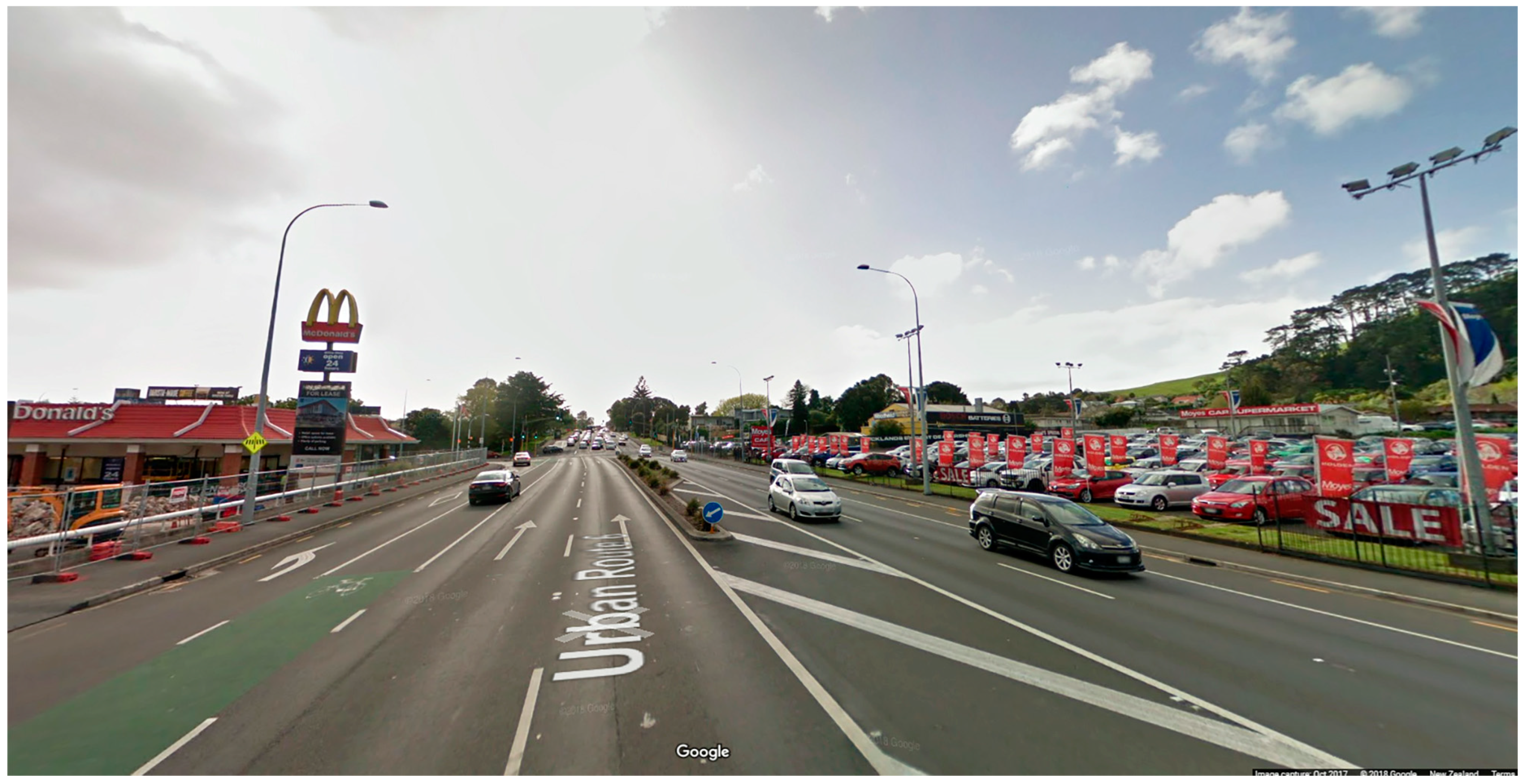
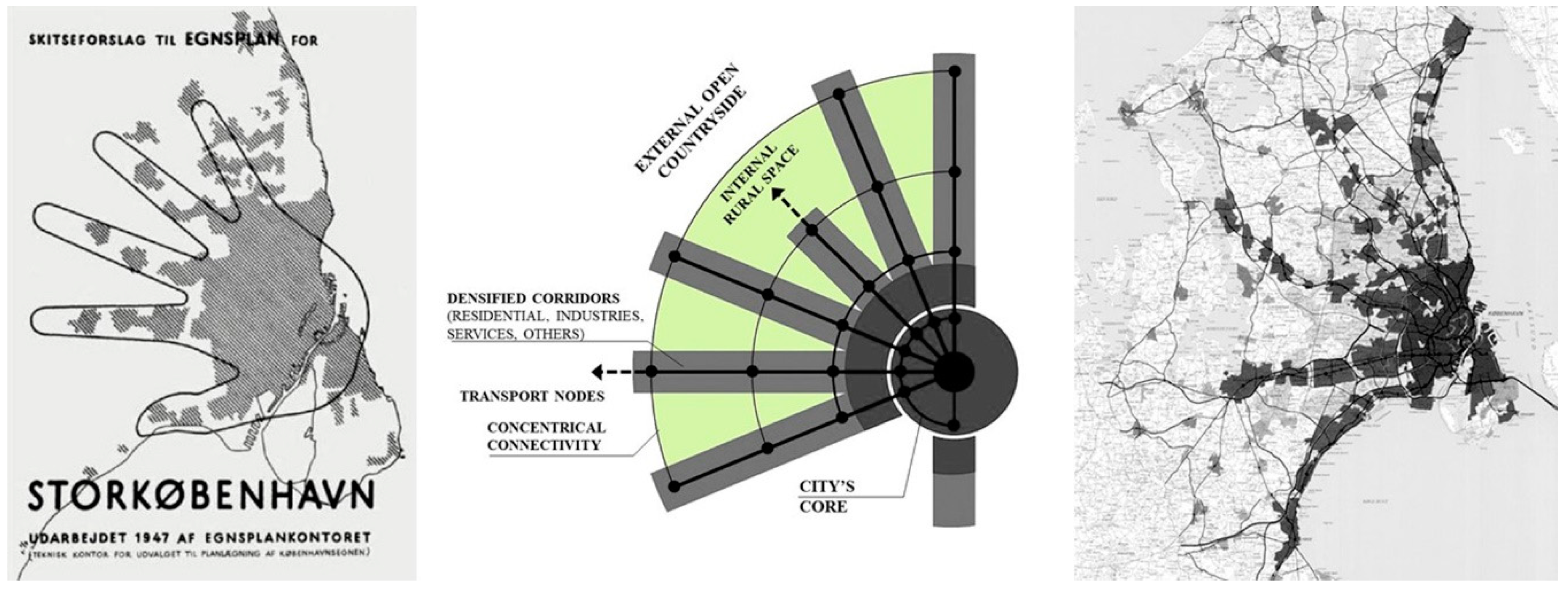
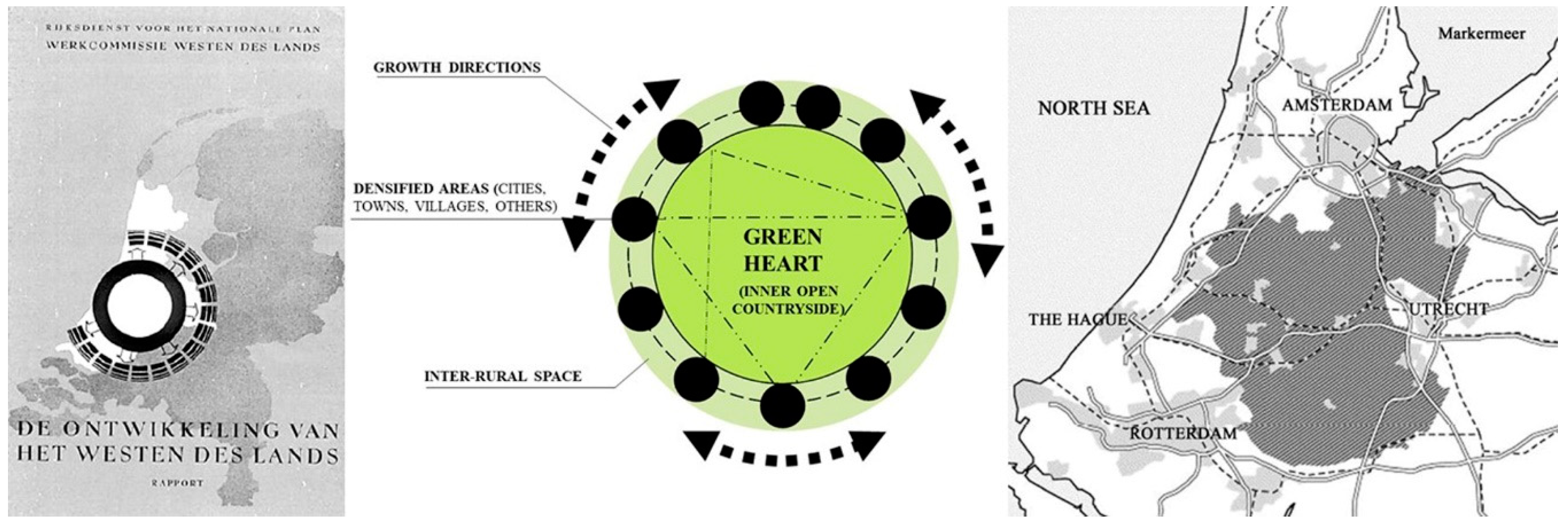
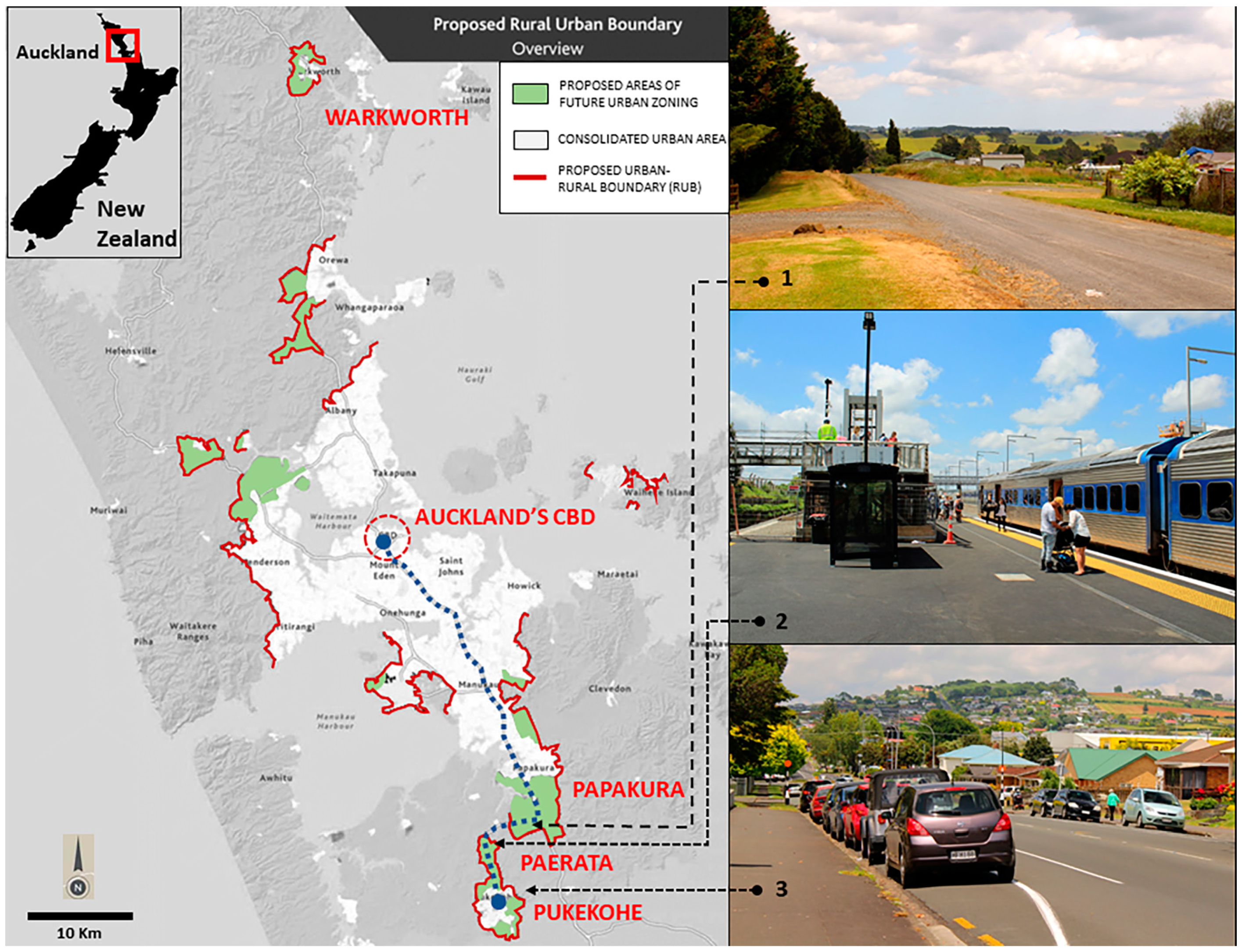
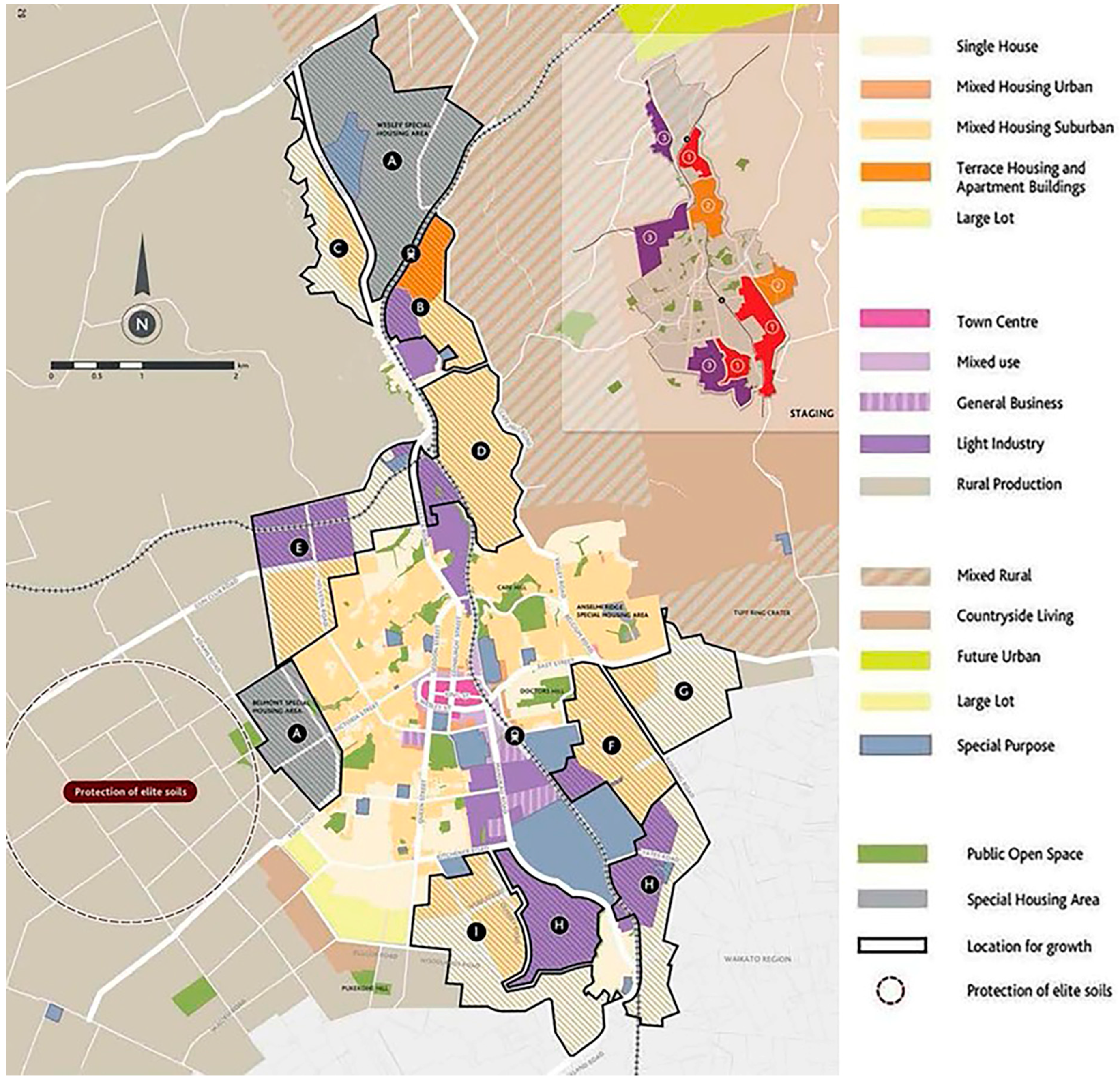
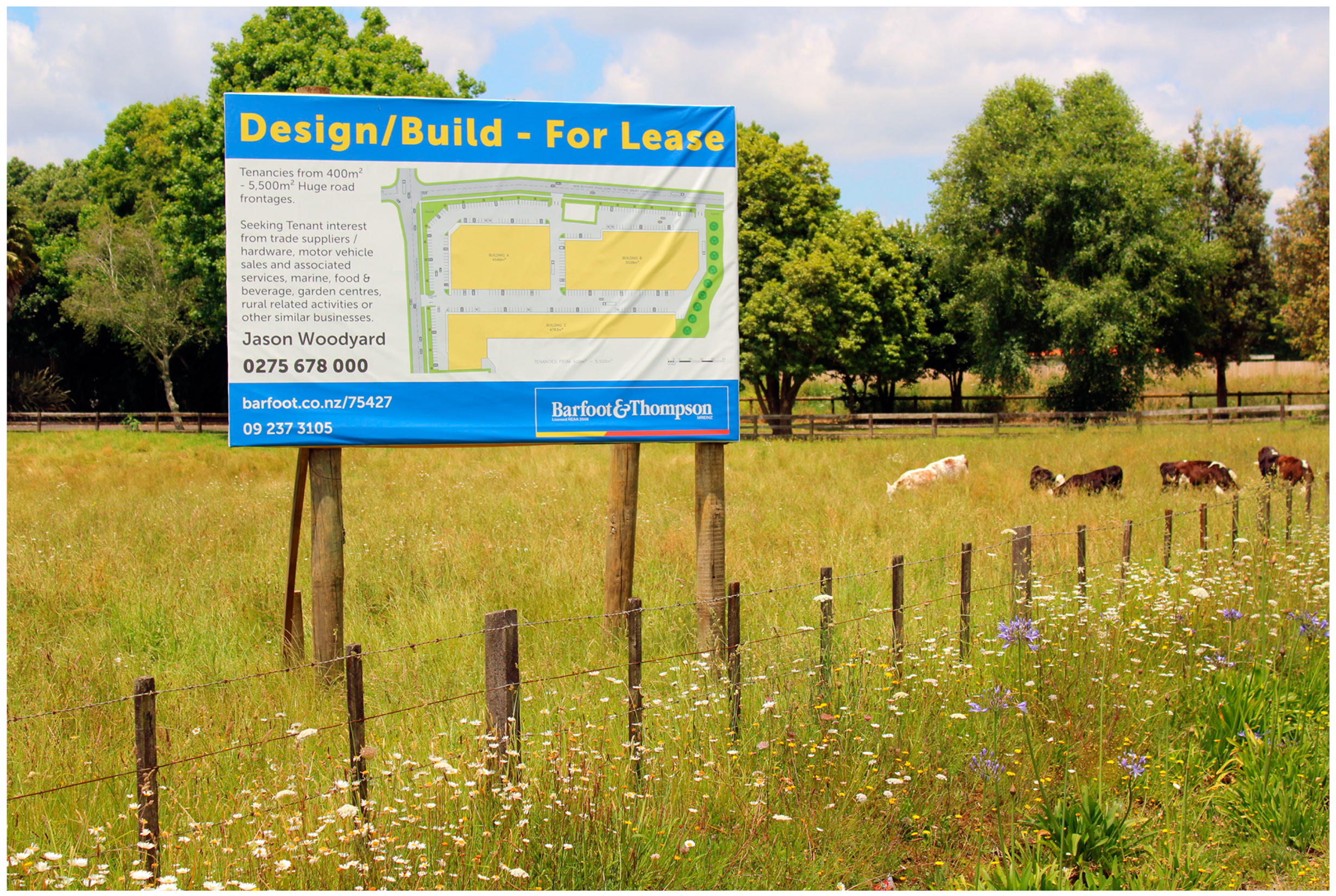
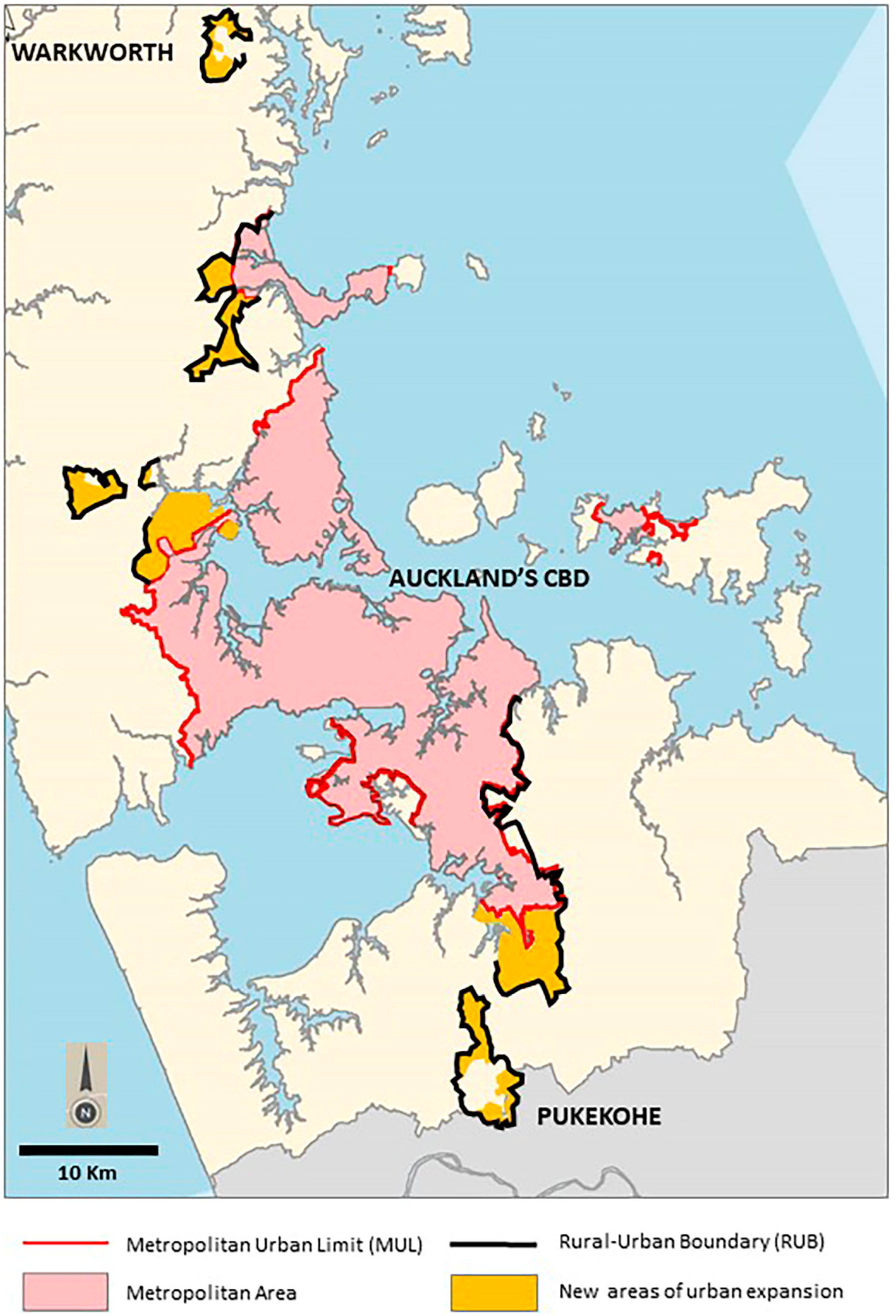
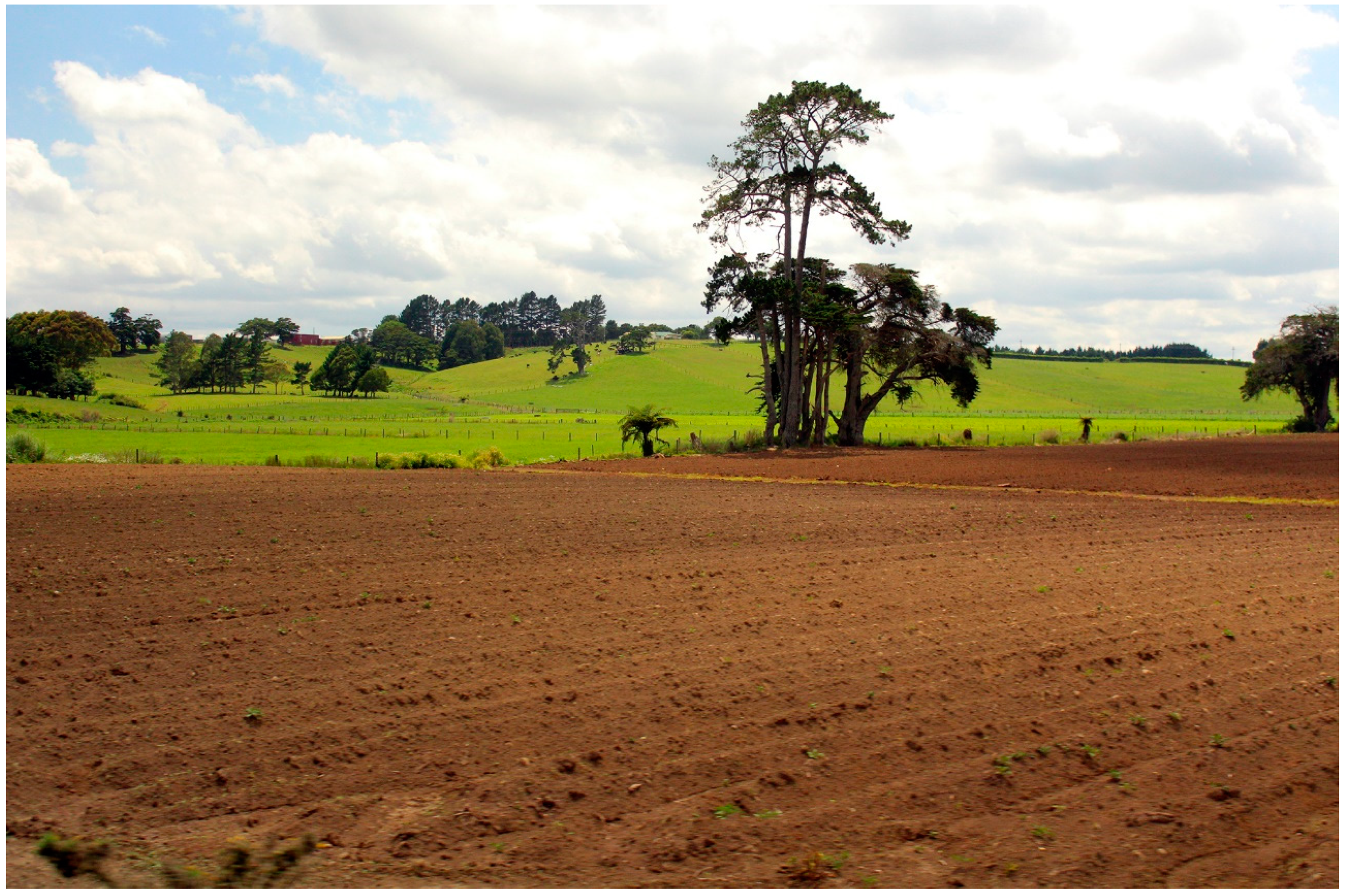
| Analysed Documents (Main Policy Reports and Studies) | Contents Analysed |
|---|---|
| (1) Auckland Council District Plan. Operative Franklin Section, 2000. [60] | Description of the Franklin District regarding population growth, definition of urban areas, natural character, and cultural heritage. |
| (2) Pukekohe Area Plan. Auckland Council, 2014 [64] | Description of the Pukekohe plan for urban growth and its implications for community engagement, economic growth, transport and natural environment. |
| (3) Addendum to the Draft Auckland Unitary Plan. Auckland Council (2013a). 15 March 2013 [67] | Definition of the Rural-Urban Boundary (RUB) and associated planning tools for enabling affordable neighbourhoods. |
| (4) Auckland Unitary Plan – Rural Urban Boundary. Discussion Paper. Transport Issues. Auckland Strategy & Research Department. Auckland Council. Auckland, New Zealand. [68] | Estimated growth in greenfield areas for investigation. Location of the RUB and transport infrastructure. |
| (5) Rural production. Comparative analysis. Greenfield Study Areas. North, North-West and South Auckland. Primary Focus. Auckland Council, 2013 [69] | Comparative analysis of rural productivity between selected greenfield areas in northern and southern Auckland. |
| (6) Capacity for Growth Study 2013 (Proposed Auckland Unitary Plan): Results. Auckland Council, 2013 [70] | Monitoring of residential, business and rural land availability. This evaluates the residential capacity, limitations for residential growth including the main urban area and also rural towns. |
| (7) Auckland Future Urban Land Supply Strategy. Auckland Council, 2017 [71] | This strategy identifies a program to sequence future urban land over 30 years and assists with the ongoing supply of greenfield land for development. |
| (8) The Auckland Plan. Auckland Council, 2018. ISBN 978-0-473-21410-4 [72] | The main planning document that provides policy orientations regarding urban growth, greenfield developments, rural development, infrastructure, community engagement, cultural (Maori) development, recreational and sport policies, historical heritage, economic growth, environment, housing and transport. |
© 2018 by the author. Licensee MDPI, Basel, Switzerland. This article is an open access article distributed under the terms and conditions of the Creative Commons Attribution (CC BY) license (http://creativecommons.org/licenses/by/4.0/).
Share and Cite
Silva, C. Auckland’s Urban Sprawl, Policy Ambiguities and the Peri-Urbanisation to Pukekohe. Urban Sci. 2019, 3, 1. https://doi.org/10.3390/urbansci3010001
Silva C. Auckland’s Urban Sprawl, Policy Ambiguities and the Peri-Urbanisation to Pukekohe. Urban Science. 2019; 3(1):1. https://doi.org/10.3390/urbansci3010001
Chicago/Turabian StyleSilva, Cristian. 2019. "Auckland’s Urban Sprawl, Policy Ambiguities and the Peri-Urbanisation to Pukekohe" Urban Science 3, no. 1: 1. https://doi.org/10.3390/urbansci3010001
APA StyleSilva, C. (2019). Auckland’s Urban Sprawl, Policy Ambiguities and the Peri-Urbanisation to Pukekohe. Urban Science, 3(1), 1. https://doi.org/10.3390/urbansci3010001





